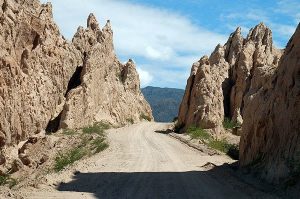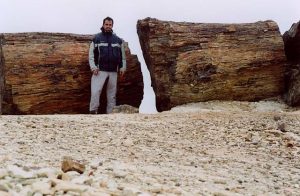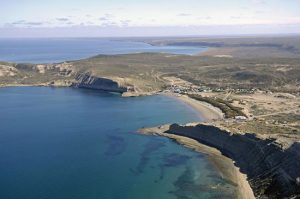What is Cave of the Hands
Named for its cave paintings with mainly hand motifs, the Cueva de las Manos houses an impressive, perfectly preserved collection of rock art dating back 13,000 years. An archaeological treasure on Route 40.
Delve into the rugged landscape of the Río Pinturas canyon and discover the largest and most dramatic sample of our ancestors in the world.
History of the Cave of the Hands
This magnificent sample of rock art is found in the Río Pinturas canyon, a deep gorge with a river running through the center surrounded by archaeological sites on both sides.
These sites evidence pre-Columbian settlements of hunters from the 10th millennium BC, which means that they are of great importance for understanding prehistoric human habitats and the first settlements in South America.
Detailed archaeological investigation of the area began in the late 1960s and has continued ever since. The hunter’s ancestors have been found to have used the cannon for protection and sustenance, and the artwork represents original evidence of hunter-gatherer culture and practices.
In view of their importance, UNESCO declared the caves a World Heritage Site in 1999.
Paintings in the Cave of the Hands
It is believed that handprints were created by impregnating a liquid pigment extracted from plants that were blown around a hand, so a hollow bone was used as a tube.
This may be the reason why most of the prints are from left hands as the artists sprayed the paint with their right hand.
As you travel the remote paths to the caves, you can also see native animals such as guanacos and ñandúes also represented in the paintings and that even today are common inhabitants in the area and at the time were painted as part of the scenes of life daily.
For example the guanaco hunt.
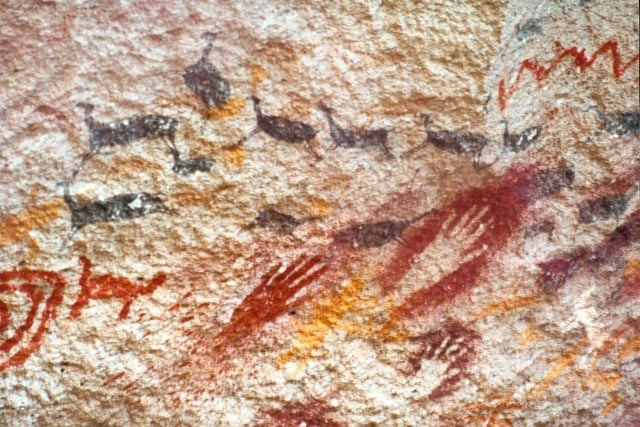
Regarding the composition, the vibrant colors were achieved by using mineral pigments and the berry of the Calafate plant as ink, mixed with some type of binder.
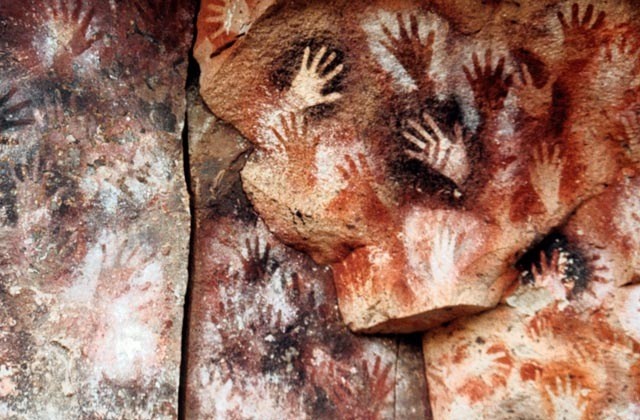
To preserve the paintings, guanaco grease was applied as a sealer as well as urine.
As for why so many hands in particular were the “subject” of art, the answer to this invites the visitor to reflect …
Where is the Cave of the Hands
Cueva de las Manos is a site of cave paintings that is located in the Pinturas river canyon, in the Estancia Cueva de las Manos between the towns of Perito Moreno and Bajo Caracoles to the Northwest in the Province of Santa Cruz
Map of the Cave of the Hands
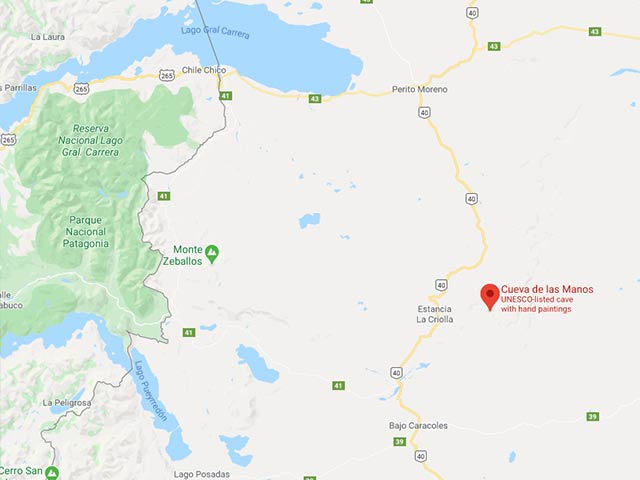
How to get to the Cave of the Hands
The Cueva de las Manos is often considered an intermediate stop and a prehistoric highlight on the legendary Route 40.
From Los Antiguos it is about 176 kilometers, it is reached by Route 40 and another access road (gravel)
The Estancia Cueva de las Manos is the starting point of a spectacular walk to the caves.
Once at the estancia, you can hike for an hour to the canyon, cross the river, and then climb to the other side. It is a spectacular adventure where you will also have encounters with guanacos and ostriches.
Planning your visit to the Cueva de las Manos
To get to the Cueva de Los Manos, you will have to deviate from Route 40 at the height of Bajo Caracoles, and travel a remote gravel road.
The surrounding beauty and wildlife sightings will keep you entertained until you reach the cave of the hands.
You will have to pay an entrance fee (equivalent to about $ 10, cash only) to explore the caves, which includes the price of the mandatory Spanish / English speaking guide. Tours last one hour and can be booked throughout the year. The area can also be visited all year round due to its mild climate, but if you are going to do a specific hiking route to the caves, it may be at a specific time, and we also recommend that you make sure that the local accommodation is open .
Cave of the hands
Despite the fact that Paleolithic works of art have been naturally well preserved, human vandalism (touching surfaces and removing fragments) has threatened the continuity of this conservation and therefore the paintings are now fenced off.
This is not a problem to see, but it is important to stand out when it comes to taking pictures.
Where to stay in the Cueva de las Manos
There is no accommodation at Cueva de las Manos – the original ranch has been purchased by the Patagonia Park and the accommodation is private.
The closest accommodation to the north is in Perito Moreno (2 hrs, 110 km away) or to the south the Estancia La Angostura near Gobernador Gregores (3.25 hrs, 240 km away) always on Route 40.
What the Cave of the Hands means for Art
Seven thousand years before the first book was created, and four thousand years before the Egyptians began to write their hieroglyphs on the walls, the hunters of Patagonia documented their stories in the caves of hands.
Each impression was a personal recognition of their life, and each group of hands a demonstration of their community. Then, around these hands, they drew pictures of their daily activities that are a testament to their culture.
The main source of food was the guanaco, a llama-like animal that is easily available in this area. The cave drawings show men hunting the creatures with primitive weapons but ingenious tactics.
In one painting, a crack in the rock is used to represent a ravine in which hunters chase animals, making them easier to catch.
There are lizards and spiders, pregnant animals, baby animals, and even evil spirits in the pictures. The things that make your world what it is are all represented on the rock.
The stories in the Cave of the Hands
There is something good in not knowing everything. The imagination is free to fill in the blanks.
You can imagine the tribe sitting here, hunched around a fire, eating their guanaco, turning their skin into clothing, and painting the stories of the day on the walls around them.
If you look at these images now that scene comes to life: men chasing animals, yelling at each other to surround a herd, to proudly bring their reward to their families.
Their stories have not been lost. Their lives have not been forgotten. Their paintings are more than a journal to themselves because they have become a record of time and a constant reminder of their existence.
The former residents of the Cueva de las Manos have become what every artist, writer, and even blogger dreams of being: storytellers.
[subpages]



